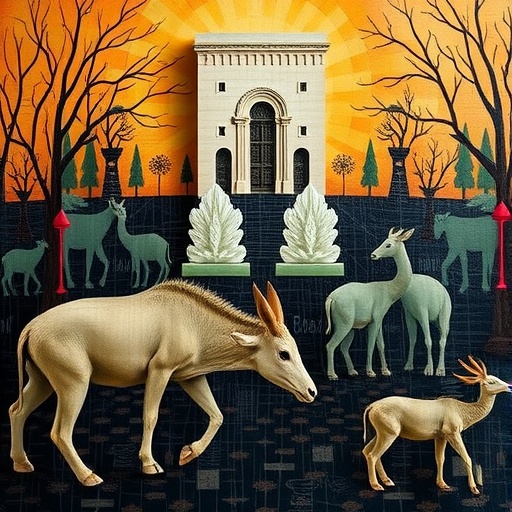The intricate interplay between human society and the natural world is a topic of growing importance in evolutionary biology. A recent analysis by an international team of biologists from Washington University in St. Louis has shed light on how religion, politics, and war not only shape sociocultural landscapes but also profoundly influence the evolutionary processes affecting urban ecosystems. This exploration opens new avenues for understanding biodiversity in urbanized environments, urging a more holistic approach to the design and management of cities.
Traditionally, the study of urban evolutionary biology has been dominated by ecological considerations, often neglecting the profound implications of human social structures. As the co-lead author Elizabeth Carlen articulates, it is paramount to recognize that human decisions, especially in urban settings, act as powerful agents of change in biological processes. This insight challenges the historical separation of human endeavors from the sphere of biological inquiry, emphasizing that urban areas, marked by high human activity, present unique evolutionary dynamics.
The review published in Nature Cities underscores that religious practices significantly shape urban biodiversity, thereby catalyzing evolutionary changes in local flora and fauna. This study suggests that the human dimension, encapsulated in religious activities, creates new niches for species, sometimes resulting in genetic divergence among populations. The authors propose various case studies, such as the phenomenon observed in Oviedo, Spain, where construction around religious sites led to genetic drift in populations of fire salamanders. It showcases how even small alterations in urban design driven by human phenomena like religion can have cascading effects on biodiversity.
.adsslot_5Pog71vTiI{ width:728px !important; height:90px !important; }
@media (max-width:1199px) { .adsslot_5Pog71vTiI{ width:468px !important; height:60px !important; } }
@media (max-width:767px) { .adsslot_5Pog71vTiI{ width:320px !important; height:50px !important; } }
ADVERTISEMENT
Furthermore, the ritualistic release of animals during religious events introduces another layer of complexity to urban evolutionary processes. When animals such as birds or fish are released far from their native habitats, this human-facilitated gene flow can disrupt local populations, raising questions about the long-term ecological impacts. These practices, often taken for granted, illustrate the unintended consequences that socio-cultural behaviors can have on urban wildlife, promoting discussions about responsible wildlife management.
Political factors also play a critical role in how urban ecosystems evolve, often directing the conservation and management efforts that influence biodiversity. Carlen’s research in the American Midwest highlights the impact of political decisions on habitat structure. For example, urban planning that prioritizes visibility for law enforcement can create landscapes that are less hospitable for certain wildlife species. The removal of underbrush to ensure visibility can often leave small animals, such as raccoons, vulnerable to predation, underscoring the delicate balance between urban safety measures and ecological integrity.
Moreover, war and conflict contribute to the evolution of urban organisms in unpredictable ways. The review draws attention to the utility of digital technology in documenting biological changes during wartime. The authors cite innovative studies leveraging social media to track animal behaviors and adaptations, such as the presence of wildlife in conflict-affected areas. Observations of urban wildlife adapted to the challenges of war present unique research opportunities, revealing how extreme human conditions can reshape ecological outcomes.
The intersection of religion, politics, and war creates a complex web of influences that can drive evolutionary change within urban settings. While these elements are often viewed independently, their interconnectedness can lead to profound and sometimes chaotic effects on biodiversity. For researchers, this represents a call to intertwine these disciplines in their studies, integrating social phenomena into biological frameworks to foster a broader understanding of urban ecosystems.
By elucidating the multifaceted interactions between human actions and urban ecosystems, this study advocates for a reevaluation of how cities are structured and managed. Enhancing biodiversity in urban landscapes not only meets conservation goals but also enriches the human experience by promoting more resilient and thriving ecosystems. Understanding the evolutionary implications of our social choices can empower city planners and policymakers to create environments that are not only habitable but also biologically diverse.
In conclusion, the insights offered in this review illuminate the critical need for an integrated approach that acknowledges the substantial impact of religion, politics, and war on urban biodiversity and evolutionary processes. As cities continue to evolve under the pressures of social constructs, biologists must rise to the challenge of understanding and documenting these changes. Through interdisciplinary collaboration, the development of new frameworks can lead to a more sustainable coexistence between urban wildlife and human populations, fostering environments that benefit both parties.
Understanding these complex relationships may transform how societies perceive and engage with their environments as we strive for a balance that supports not only the urban growth of humanity but also the intricate tapestry of life that we share our cities with.
Subject of Research: The impact of religion, politics, and war on urban evolutionary biology
Article Title: Legacy effects of religion, politics and war on urban evolutionary biology
News Publication Date: 2-Jul-2025
Web References: Nature Cities
References: Carlen, E., et al., Nature Cities.
Image Credits: Washington University in St. Louis
Keywords
Urban ecology, biodiversity, evolutionary biology, human impact, religious practices, political influence, war effects, wildlife management, urban planning, conservation strategies.
Tags: biodiversity in urban environmentsconflict and wildlife adaptationevolutionary dynamics in citiesholistic urban design strategieshuman influence on evolutionary processesimpact of religion on biodiversityinterdisciplinary approaches to urban biologypolitics and urban ecosystemsrole of religious practices in ecosystemsurban ecology and social structuresurban wildlife evolutionurbanization and species adaptation





